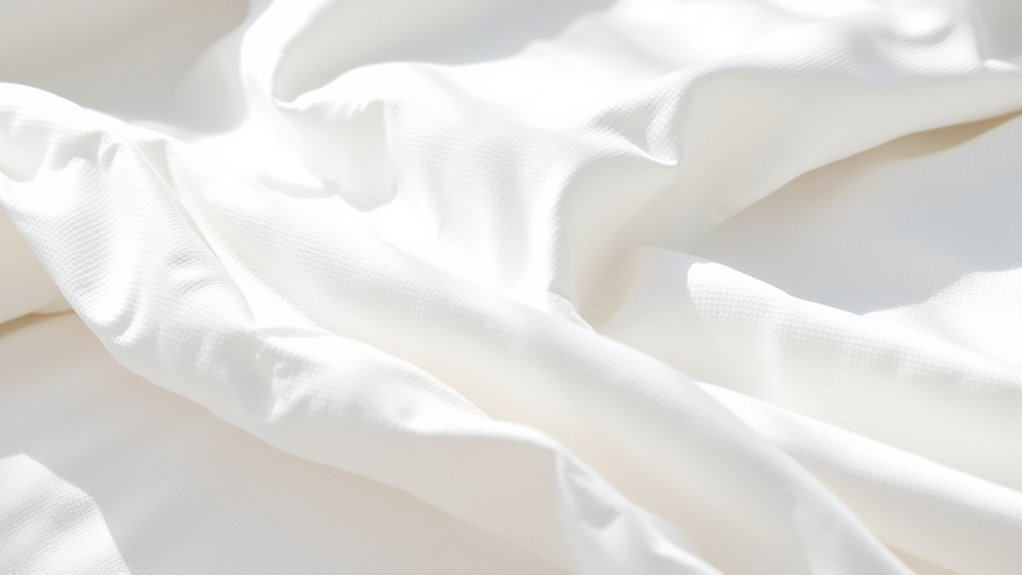To manage night sweats, choose breathable bedding made from natural fibers like cotton, linen, or bamboo that promote airflow and wick away moisture. Look for lightweight, open-weave fabrics that keep you cool and dry throughout the night. Regularly wash your bedding to maintain its moisture-wicking properties and avoid heavy or densely woven fabrics. If you want to learn more about selecting the best breathable bedding for your needs, keep exploring your options.
Key Takeaways
- Choose bedding made from natural fibers like cotton, linen, or bamboo for optimal breathability and moisture-wicking.
- Opt for lightweight, open-weave fabrics such as percale or linen to enhance airflow and reduce night sweats.
- Avoid heavy, densely woven, or synthetic fabrics like polyester that trap heat and moisture.
- Use moisture-wicking treatments or bedding designed to draw sweat away from the skin for better dryness.
- Regularly wash bedding with gentle detergents to maintain breathability and moisture-management properties.

If you want a better night’s sleep, breathable bedding can make a considerable difference. Night sweats disrupt your rest, leaving you feeling exhausted and uncomfortable. The right bedding helps regulate your body temperature, preventing excessive sweating and making sure you stay cool and dry throughout the night. When your bedding allows air to circulate freely, it pulls heat away from your body and wicks moisture away, reducing the chances of waking up drenched in sweat. This not only improves comfort but also supports your overall sleep quality, allowing you to wake feeling refreshed rather than fatigued. Choosing breathable bedding means paying attention to the fabric. Natural fibers like cotton, linen, and bamboo are excellent options because they are inherently breathable. Cotton, especially high-quality Egyptian or Pima varieties, offers softness and excellent airflow. Linen, made from flax, boasts a highly breathable and moisture-wicking structure, making it ideal for hot sleepers or those prone to night sweats. Bamboo fabric, often derived from viscose or rayon, combines breathability with a silky feel and natural moisture-wicking properties. These materials create a cooler sleep environment compared to synthetic fabrics like polyester or microfiber, which tend to trap heat and moisture. Additionally, fabric construction such as open weaves or lightweight weaves can further enhance airflow and breathability. The weave of the fabric also matters. A loose, open weave allows more air to pass through, enhancing breathability. Percale cotton, for example, features a tight yet crisp weave that promotes good airflow. Sateen weaves, while softer, can sometimes reduce breathability, so it’s best to opt for a percale or similar open weave for night sweat concerns. Additionally, bedding with a moisture-wicking treatment or properties can help draw sweat away from your skin, keeping you dry and comfortable throughout the night. These treatments are often applied to natural fibers and can greatly improve your sleep experience. Maintaining breathable bedding is equally important. Regular washing keeps the fibers clean and allows the fabric to retain its moisture-wicking properties. Using gentle detergents and avoiding fabric softeners can help preserve the natural breathability of the material. Proper care ensures that your bedding continues to promote airflow and moisture control over time. Remember, bedding that is too heavy or densely woven can trap heat, so opting for lightweight, breathable options is best for night sweat relief. When you select bedding designed for breathability, you’re taking a proactive step toward a cooler, more comfortable sleep environment. This small change can lead to considerable improvements in your sleep quality, helping you wake up feeling more rested and less drained.
Frequently Asked Questions
How Often Should I Wash Breathable Bedding?
You should wash breathable bedding at least once a week to keep it fresh and free of sweat, oils, and bacteria. If you tend to sweat heavily or have allergies, consider washing more often, like every 3-4 days. Always follow the care instructions on your bedding to preserve its breathable qualities. Regular washing not only maintains hygiene but also guarantees your bedding stays comfortable and effective at regulating temperature.
Are There Specific Materials Best for Night Sweats?
Did you know that around 37 million Americans suffer from night sweats? For the best sleep, choose materials like cotton, bamboo, or linen. These fabrics are highly breathable, helping to wick away moisture and regulate your body temperature. Avoid synthetic fibers like polyester, which trap heat and moisture. Sticking to natural, lightweight fabrics can markedly improve your comfort and reduce night sweats, making your sleep more restful.
Can Breathable Bedding Help Reduce Sleep Disruptions?
Yes, breathable bedding can help reduce sleep disruptions caused by night sweats. By allowing moisture to escape and promoting airflow, breathable materials keep you cooler and drier throughout the night. This comfort minimizes waking up due to overheating or sweating, helping you stay asleep longer. Switching to breathable bedding like cotton or linen can make a noticeable difference in your sleep quality, especially if night sweats disturb your rest regularly.
Is Breathable Bedding Suitable for All Climates?
Breathable bedding is generally suitable for all climates, helping you stay comfortable year-round. Did you know that 65% of people report better sleep with temperature-regulating bedding? In warmer weather, it prevents overheating, while in cooler temperatures, it helps retain just enough warmth. You’ll find breathable bedding adapts well, making it an ideal choice no matter where you live, ensuring restful sleep regardless of climate changes.
How Does Breathable Bedding Compare to Cooling Mattresses?
Breathable bedding helps you stay cool and comfortable by promoting airflow and moisture wicking, making it ideal for hot nights. Cooling mattresses, on the other hand, often incorporate advanced materials or gel-infused foams to actively regulate temperature throughout the night. While both improve sleep quality, breathable bedding is simpler and less expensive, offering a passive cooling effect, whereas cooling mattresses provide a more consistent, high-tech solution for temperature control.
Conclusion
By choosing breathable bedding, you’re taking a smart step toward more comfortable nights. It helps wick away moisture, keeps you cool, and minimizes night sweats, so you wake up feeling refreshed. Remember, when it comes to quality sleep, you get what you pay for. Don’t let discomfort be a thorn in your side; invest in the right bedding and sleep soundly through the night. After all, a good night’s sleep is worth its weight in gold.









